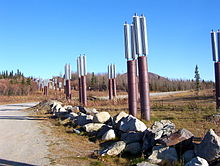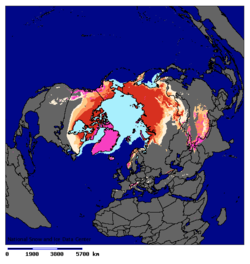Permafrost
|
|
This article needs additional citations for verification. Please help improve this article by adding citations to reliable sources. Unsourced material may be challenged and removed. (June 2007) |
| Wikinews has related news: Scientists warn thawing Siberia may trigger global meltdown |
In geology, permafrost, cryotic soil or permafrost soil is soil at or below the freezing point of water (0 °C or 32 °F) for two or more years. Ice is not always present, as may be in the case of nonporous bedrock, but it frequently occurs and it may be in amounts exceeding the potential hydraulic saturation of the ground material. Most permafrost is located in high latitudes (i.e. land close to the North and South poles), but alpine permafrost may exist at high altitudes in much lower latitudes. Permafrost accounts for 0.022% of total water and exists in 24% of exposed land in the Northern Hemisphere.
The extent of permafrost can vary as the climate changes. Today, a considerable area of the Arctic is covered by permafrost (including discontinuous permafrost). Overlying permafrost is a thin active layer that seasonally thaws during the summer. Plant life can be supported only within the active layer since growth can occur only in soil that is fully thawed for some part of the year. Thickness of the active layer varies by year and location, but is typically 0.6–4 m (2.0–13 ft) thick. In areas of continuous permafrost and harsh winters the depth of the permafrost can be as much as 1,493 m (4,898 ft) in the northern Lena and Yana River basins in Siberia. Permafrost can also store carbon, both as peat and as methane. The most recent work investigating the permafrost carbon pool size estimates that 1400-1700 Gt of carbon is stored in permafrost soils worldwide. [1]. This large carbon pool represents more carbon than currently exists in all living things and twice as much carbon as exists in the atmosphere.
Contents[hide] |
[edit] Continuous and discontinuous permafrost


Permafrost will typically form in any climate where the mean annual air temperature is less than the freezing point of water. Exceptions are found in moist-wintered forest climates, such as in Northern Scandinavia and the North-Eastern part of European Russia west of the Urals, where snow acts as an insulating blanket. The bottoms of many glaciers can also be free of permafrost.
Typically, the below-ground temperature will be less variable from season to season than the air temperature, with temperatures tending to increase with depth. Thus, if the mean annual air temperature is only slightly below 0 °C (32 °F), permafrost will form only in spots that are sheltered — usually with a northerly aspect. This creates what is known as discontinuous permafrost. Usually, permafrost will remain discontinuous in a climate where the mean annual soil surface temperature is between -5 and 0 °C (23 and 32 °F). In the moist-wintered areas mentioned before, there may not be even discontinuous permafrost down to −2 °C (28 °F). Discontinuous permafrost is often further divided into extensive discontinuous permafrost, where permafrost covers between 50 and 90 percent of the landscape and is usually found in areas with mean annual temperatures between -2 and -4 °C (28 and 25 °F), and sporadic permafrost, where permafrost cover is less than 50 percent of the landscape and typically occurs at mean annual temperatures between 0 and -2 °C (32 and 28 °F).
In soil science, the sporadic permafrost zone is abbreviated SPZ and the extensive discontinuous permafrost zone DPZ.
There are exceptions in un-glaciated Siberia and Alaska where the present depth of permafrost is a relic of climatic conditions during glacial ages where winters were up to 11 °C (20 °F) colder than those of today. At mean annual soil surface temperatures below −5 °C (23 °F) the influence of aspect can never be sufficient to thaw permafrost and a zone of continuous permafrost (abbreviated to CPZ) forms. There are also "fossil" cold anomalies in the Geothermal gradient in areas where deep permafrost developed during the Pleistocene that still persists down to several hundred metres. The Suwałki cold anomaly in Poland led to the recognition that similar thermal disturbances related to Pleistocene-Holocene climatic changes are recorded in boreholes throughout Poland. [1]
A line of continuous permafrost in the Northern Hemisphere (Frozen Ground 28, 2004, p5) is formed from the most northerly points at which permafrost sometimes thaws or is interrupted by regions without permafrost. North of this line all land is covered by permafrost or glacial ice. The "line" of continuous permafrost lies further north at some longitudes than others and can gradually move northward or southward due to regional climatic changes. In the southern hemisphere, most of the equivalent line would fall within the Southern Ocean if there were land there. Most of the Antarctic continent is overlain by glaciers.
In the Andes at Atacama Desert permafrost extends down to an altitude of 4,400 metres and is continuous above 5,600 metres.
[edit] Changes in permafrost extent
In Yukon, the zone of continuous permafrost might have moved 100 kilometres poleward since 1899, but accurate records only go back 30 years. It is thought that permafrost thawing could exacerbate global warming by releasing methane and other hydrocarbons, which are powerful greenhouse gases.[2] [3] [4] It also could encourage erosion because permafrost lends stability to barren Arctic slopes.
At the Last Glacial Maximum, continuous permafrost covered a much greater area than it does today, covering all of ice-free Europe south to about Szeged (southeastern Hungary) and the Sea of Azov (then dry land) and China south to Beijing. In North America, only an extremely narrow belt of permafrost existed south of the ice sheet at about the latitude of New Jersey through southern Iowa and northern Missouri. In the southern hemisphere, there is some evidence for former permafrost from this period in central Otago and Argentine Patagonia, but was probably discontinuous, and is related to the tundra.
[edit] Ecological consequences
Formation of permafrost has significant consequences for ecological systems, primarily due to constraints imposed upon rooting zones, but also due to limitations on den and burrow geometries for fauna requiring subsurface homes. Of course, there are secondary effects from species dependent on plants and animals whose habitat is constrained by the permafrost. One of the most widespread examples is the dominance of Black Spruce in extensive permafrost areas, since this species can tolerate rooting pattern constrained to the near surface.[5]
[edit] Patterned ground
Patterned ground is a term used to describe the distinct, and often symmetrical geometric shapes formed by ground material in periglacial regions.
-
Stone rings on Spitsbergen
-
Ice wedges seen from top
-
Phoenix landing-day image near north pole of Mars showing flat terrain, containing what appears to be a polygonal pattern, stretching from the foreground to the horizon.
[edit] Time to form deep permafrost
| Time (yr) | Permafrost depth |
|---|---|
| 1 | 4.44 m (14.6 ft) |
| 350 | 79.9 m (262 ft) |
| 3,500 | 219.3 m (719 ft) |
| 35,000 | 461.4 m (1,514 ft) |
| 100,000 | 567.8 m (1,863 ft) |
| 225,000 | 626.5 m (2,055 ft) |
| 775,000 | 687.7 m (2,256 ft) |
It has been calculated that the time required to form the deep permafrost underlying Prudhoe Bay, Alaska is 500,740 years. This time extends over several glacial and interglacial cycles of the Pleistocene and suggests that the present climate of Prudhoe Bay is probably considerably warmer than it has been on average over that period. Such warming over the past 15,000 years is widely accepted.[citation needed] The table to the right shows that the first hundred metres of permafrost forms relatively quickly but that deeper levels take progressively longer.
[edit] Construction on permafrost
Building on permafrost is difficult due to the heat of the building (or pipeline) thawing the permafrost and sinking. This problem has three common solutions: using foundations on wood piles; building on a thick gravel pad (usually 1–2 metres/3.3-6.6 feet thick); or using anhydrous ammonia heat pipes. The Trans-Alaska Pipeline System uses insulated heat pipes to prevent the pipeline from sinking. Qingzang railway in Tibet was built using a variety of methods to keep the ground cool.
At the Permafrost Research Institute in Yakutsk, it has been found that the sinking of large buildings into the ground can be prevented by using stilts extending down to about fifteen metres or more. At this depth the temperature does not change with the seasons, remaining at about -5 °C (23F).
[edit] See also
- Arctic methane release
- Drunken trees
- International Permafrost Association
- Permafrost Young Researchers Network
- Palsa
- Pingo
- Alas
- Yedoma
- Permafrost carbon cycle
- Qingzang Railway
[edit] References

- ^ [Tarnocai, C., J. G. Canadell, E. A. G. Schuur, P. Kuhry, G. Mazhitova, and S. Zimov (2009), Soil organic carbon pools in the northern circumpolar permafrost region, Global Biogeochemical Cycles, 23]
- ^ The Guardian
- ^ The effect of permafrost thaw on old carbon release and net carbon exchange from tundra
- ^ The Economist: Thaw point
- ^ C. Michael Hogan, Black Spruce: Picea mariana, GlobalTwitcher.com, ed. Nicklas Stromberg, November, 2008
[edit] External links
| Wikimedia Commons has media related to: Permafrost |
- International Permafrost Association (IPA)
- What is Permafrost?, Geological Survey of Canada
- How rapidly is permafrost changing? What are the impacts of these changes? from *NOAA
- Melting Russian Permafrost Could Accelerate Global Warming - ENS (7 September 2006)
- Mike W. Smith's page on permafrost in Canada
- Earth's permafrost starts to squelch — BBC (29 December 2004)
- PERMAFROST: A Building Problem For Alaska
- Permafrost Young Researchers Network (PYRN)
- United States Permafrost Association (USPA)
- Air Conditioning Lubricant named PermaFrost
- Conversion Calculator
- Permafrost Research in 1940s-1950s
- Geophysical Institute Permafrost Lab, University of Alaska Fairbanks
|
|||||||||||||||||||









